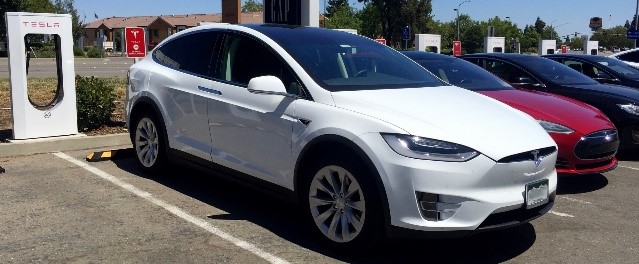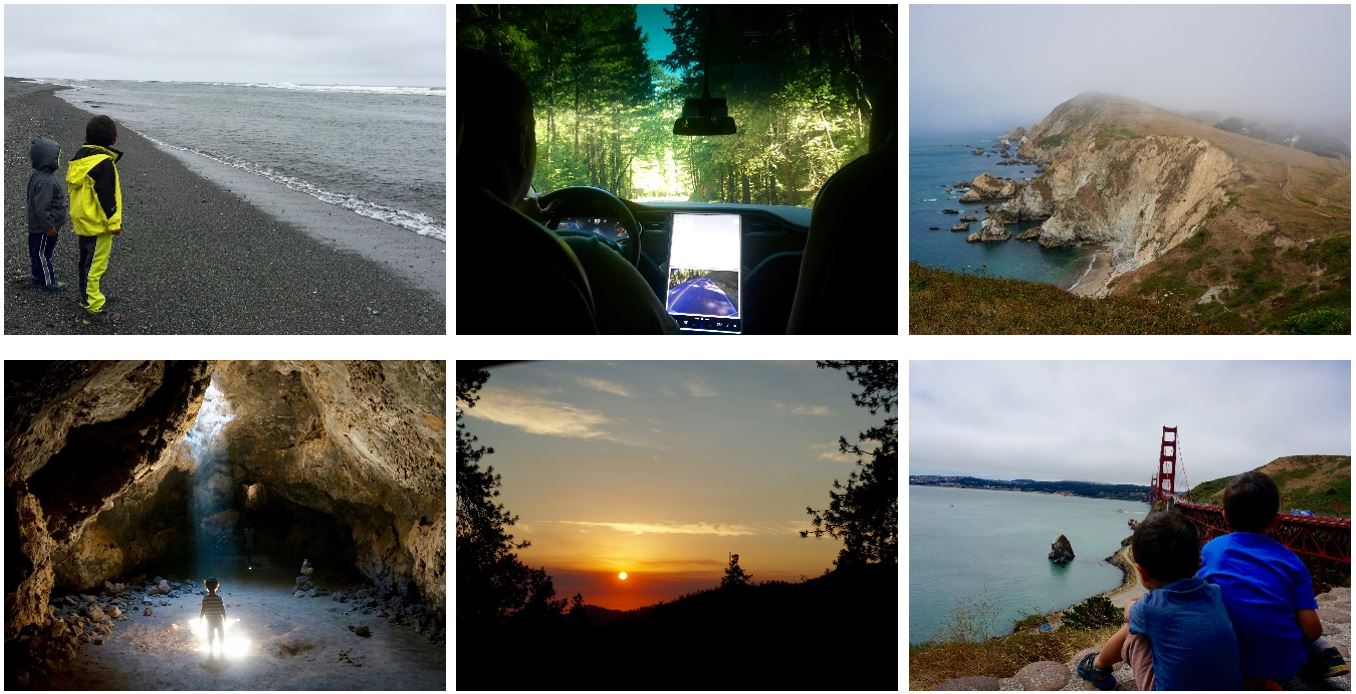3,700-miles, two young boys, 100-degree heat… and an electric car… what could go wrong?
An American West EV road trip by Val Hovland (from a summer 2017 trip)
Dinosaur National Monument, Capitol Reef National Park, Redwoods National Park
For my college essay for MIT, I wrote about my car. My little white Nissan Sentra that held my green tennis racquet in the trunk, my filing folder of debate research, dried fruit, a change of clothes, and a water bottle or two. And of course, my best friend on the lunch trips or the exploratory trips through downtown Denver where we would turn left or right based on when we found the next four letters in the alphabet.
Twenty-two years later, the car is still white, but much has changed. Two car seats in the back hold my two young boys (at the time three and five years old). The trunk in the back has baby backpacks, swim noodles, clean and dirty clothes, and a cooler. But there is also a front trunk for some more clothes, a large display inside helping us map our route or favorite the four songs the boys keep requesting or view the road behind us, and a windshield that is so big it keeps going into the back. Most importantly, there is no engine. We are in an electric car. And we are on a 16-day, 3,700-mile summer road trip through the American West!
Klamath River, Salmon at a Yurok ceremony
The impetus for our trip was a Yurok tribal ceremony at the mouth of the Klamath River for the young son of friends of ours. But that was in far northern California. We live in Boulder, Colorado.
First, out came the maps of all of the national parks, national monuments, and wilderness areas across the West. How could we plan our trip that saw beautiful places every day, allowed us to get outside and hike, didn’t spend too many hours in the car, fit within our two-weeks off, and allowed us to charge the car?
Superchargers
What do you do when the chargers are full? There we were. At the long-awaited supercharger in the middle of Los Angeles, after the longest day of the trip by far. Tired of traffic and finding ways to distract the boys. Getting very low on range, anxious to get to the extended family’s house to visit and unwind from the day, and two hungry boys to boot. But as we drove up to the dealership and rounded the corner, we found all four superchargers full! Do we wait and risk tired and hungry kids, or move on and hope we can make it to the next charger? Weighing the value of kid happiness highly, we opted to leave. We made it to our destination with a few miles left, slowly trickle charged through a regular outlet overnight, and had just enough miles to reach the next supercharger on our way out of town.
We needed a bit more planning. But I love planning. And I love spreadsheets (in my work I am known as the master of spreadsheets, though this one doesn’t need to be too complicated). We had some operating constraints and targets:
Ruby Mountains Wilderness Area, Sequoia National Park
- Plan the route to include charging stations every 200 miles (the car’s range is around 250 miles so that gave us flexibility). Ideally these charging stations are fast/DC chargers (which allow us to charge in around an hour), but if necessary (especially when we are off the main highway) we can plan an overnight stop near a Level 2 charger (one that charges the car overnight). In two cases, we plugged into a normal wall outlet to give us a few miles on a trickle charge (see green section above). And in one case, we drove north an extra 22 miles to reach a supercharger. Important resources were Plugshare.com, Google maps, and the Supercharger map (all of which are now quick links on my browser).
- Do an outdoor activity every day. It was crucial for us to get outside. We mostly hiked in national parks, national monuments, and wilderness areas, but we found on this trip that the boys like water and boating too. One challenge was Nevada: where to stop in a state that has a dearth of ‘green spots at which to stop’ when looking at the national parks/monuments map? Through a little searching, we found a beautiful refuge in the Ruby Mountain Wilderness Area. My older son also wanted to earn as many Junior Ranger badges from the national parks and monuments along the way as possible. Important resources were maps of all of the national parks and national monuments and wilderness areas for planning and the All Trails website (ahead of time) and app (during the trip. Quick tip: get the map on your phone ahead of time, then put your phone in airplane mode so the app doesn’t try to look for service and lose the map, this way you can use the app to track your progress while hiking.).
- Ideally drive less than 4 hours each day and keep the boys occupied when we are driving. We kept to this time frame most days, but did have a few long driving days. A huge bunch of new library books are a great thing to keep the boys interested in the car (Tip for next time: bring more books and bring new ones out every day instead of just keeping five for the second week of the trip). Lots of car-friendly snacks and occasional new toy cars are also crucial.
- Have fun, make time to visit friends and family, celebrate my son’s 5th birthday, and be part of a special (and all-night) brush dance ceremony on the Klamath. I love songs. Even today I get chills when remembering my friend’s brother singing “Ooohhhh, ooooohh Requa!”
Mojave National Preserve
What about when your son falls into a cactus? There we were. In the middle of the Mojave National Preserve after 4-wheel driving on some pretty rocky roads, having just successfully climbed Teutonia Peak, the sun getting low and beautifully illuminating the Joshua trees, casting long shadows. My 5-year old son, racing down the trail, was going a little too fast and at a turn fell with his hand squarely onto a cactus, thereby covering his entire palm in spikes. Some long, some quite small. He bravely held still for me to sit down on the trail and slowly remove most of the prickles that I could (only getting upset when he saw the multitool come out that I was thinking of using). For next time, I learned that you are actually supposed to remove cactus spines using tweezers and not your hands, and that regular Elmer’s glue can help remove small spines.
With a little back and forth, we had our plan. We looped from Colorado through northern Utah (I-70 through Rifle to Vernal and Salt Lake) and Nevada (I-80 through Elko to Tahoe) to California (Palo Alto, Redwood highway north to Klamath, back down through San Francisco and Sequoia National Park and Los Angeles), and returned via southern Nevada (I-15 to Lake Meade) and middle Utah (Capital Reef National Park) and back to Boulder.
Lake Tahoe, Redwoods
We immersed ourselves in so many beautiful places. The folds of rock in Dinosaur National Monument (Colorado/Utah border) where the wild Yampa meets the Green River, viewed from above at Harper’s Landing. The amazing, strong, tall redwoods in Muir National Monument and Sequoia National Park, offering shade and inspiring awe. The shimmer of Lake Tahoe from our kayak (my younger son transitioned from being scared of the waves at first to being excitedly announcing ‘here comes the swell!’). The strong wind on the Golden Gate Bridge. The lush greenery around a Trillium Falls in Redwood National Park. Light filtering through a small hole in an underground lava tube in the Mojave National Preserve. The narrows and warm water of Lake Meade. Petroglyphs and slot canyons and arches in Capitol Reef National Park. Literally cool caves as havens from the heat in Goblin Valley State Park. We even drove through a big redwood tree.
We saw wildlife. Spouting whales and loud sea lions and a bucket of tiny crawling crabs in the Pacific near Muir Beach and within Point Reyes National Seashore. A baby fox in Muir National Monument. A banana slug along the trail to Trillium Falls. Eagles and osprey flying above the wild Klamath River. Deer in Capitol Reef National Park. And the boys were excited for our horse-driven carriage ride around Eureka.
And we connected with friends and family. Friends from college offering food and places to stay. Friends from birth classes with soft woodpeckers and shells and fur decorating ceremonial outfits. Family with a new business to show us. Even new friends on the beach who shared snacks and stories or a helper on the Madaket who showed my sons the workings (drive shaft and chains for turning) of the 100-year old boat.
Some lessons and observations:
- Planning charging stops around meal times works well. Or at least you can stretch your legs and get out of the car, a very important thing to do with two young kids.
- Not all charging plugs or places charge at the same rate. Of course, we try to plug in to those that are directly serviced and not also charging a second car. But a quick call to support helped us choose the best one even when no one else was charging. Charging in 100+F heat (as in central California) takes quite a bit longer.
- Electric vehicles are growing across the west. Supercharger stations are not full in Nevada or Utah. In Colorado you see another car or two. But in California almost all plugs are full.
- The falcon-wing doors were a fun icing on the cake. They are extremely practical for getting in and out and they attract the most attention from others, which offers a good time to talk about how much we love the car – on its own and what it means for the environment.
My boys play with cars and trucks, similar to most boys. But they don’t fill up at the gas station. They take the car to plug it into the wall. They know this is the future.
Pacific near Requa (CA), Redwoods, Pt. Reyes National Seashore, Lava Tube (Mojave), Golden Gate Bridge








